Physical Address
304 North Cardinal St.
Dorchester Center, MA 02124
Gastric and duodenal metastases are found at autopsy in less than 2% of patients who die of carcinoma. Most of them are blood-borne metastases, but the stomach and duodenum are also involved by lymphatic spread or by direct extension of tumor from neighboring structures or mesenteric reflections such as the gastrocolic ligament, transverse mesocolon, and greater omentum.
Many gastric and duodenal metastases are discovered unexpectedly at surgery or autopsy, but these lesions may cause epigastric pain, nausea, vomiting, early satiety, or upper gastrointestinal (GI) bleeding. While most patients have a known underlying malignancy, some gastroduodenal metastases occur as the initial manifestation of an occult primary tumor. Certain malignancies, particularly breast cancer, can metastasize to the stomach or duodenum many years after treatment of the original lesion.
Although malignant melanoma has the highest percentage of hematogenous metastases to the GI tract, breast cancer is so much more common that it rivals melanoma as the most frequent cause of GI metastases. The stomach and duodenum are also involved by hematogenous metastases from other malignant tumors, including lung, thyroid, and testicular cancer.
Hematogenous metastases usually appear on barium studies as solitary or, more commonly, multiple discrete submucosal masses in the stomach, duodenum, or small bowel ( Fig. 21.1 ). , As these metastases outgrow their blood supply, they often undergo central necrosis, resulting in the development of centrally ulcerated submucosal masses, also known as bull’s-eye or target lesions ( Fig. 21.2 ). An unusually large, lobulated metastasis may resemble a malignant gastrointestinal stromal tumor (GIST) or even a polypoid carcinoma ( Fig. 21.3 ). Other hematogenous metastases (especially those from malignant melanoma) undergo extensive necrosis, forming giant, cavitated lesions that appear as amorphous barium collections within a bulky surrounding mass ( Fig. 21.4 ). , These cavitated metastases are particularly well shown on computed tomography (CT).
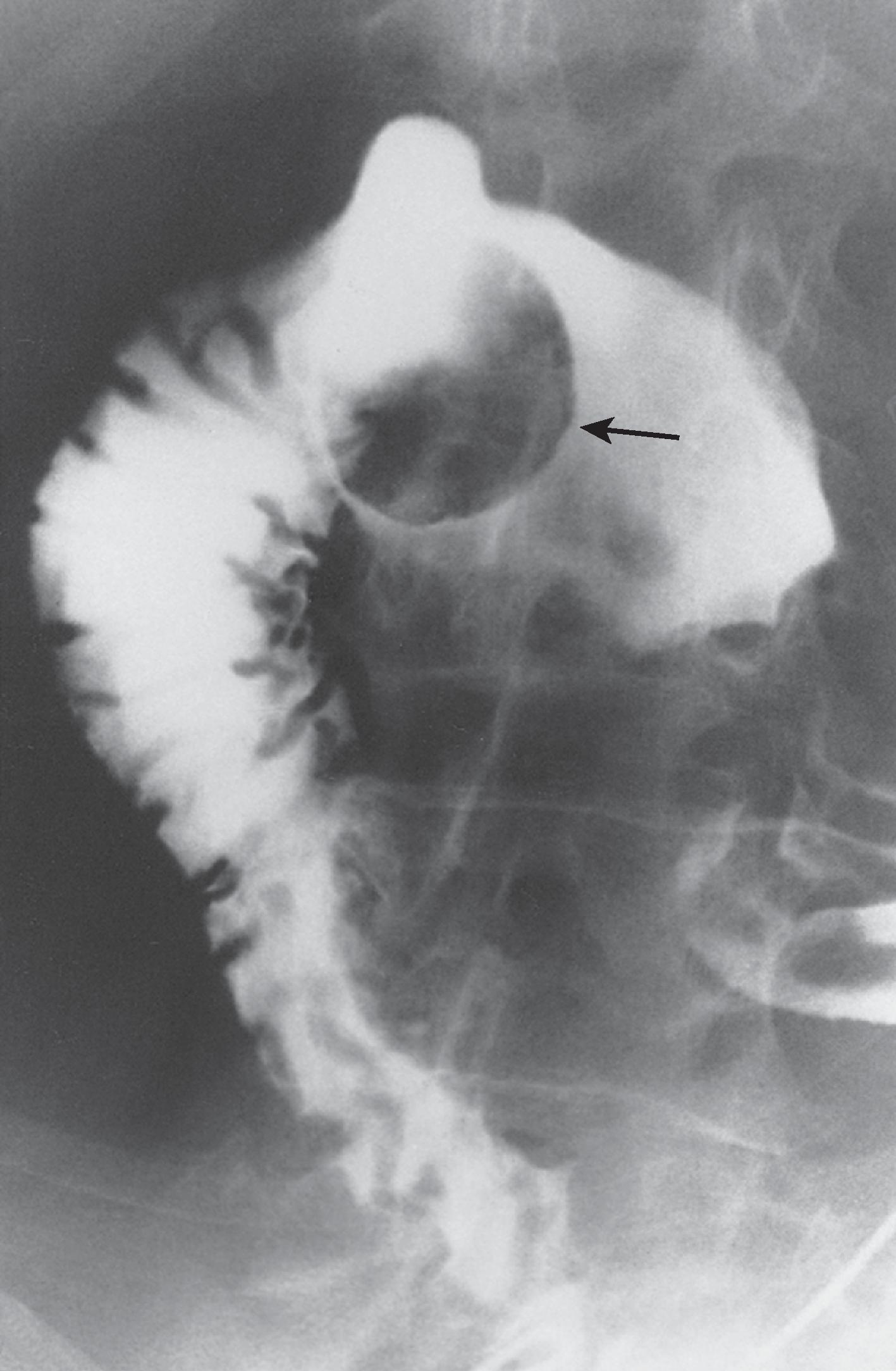
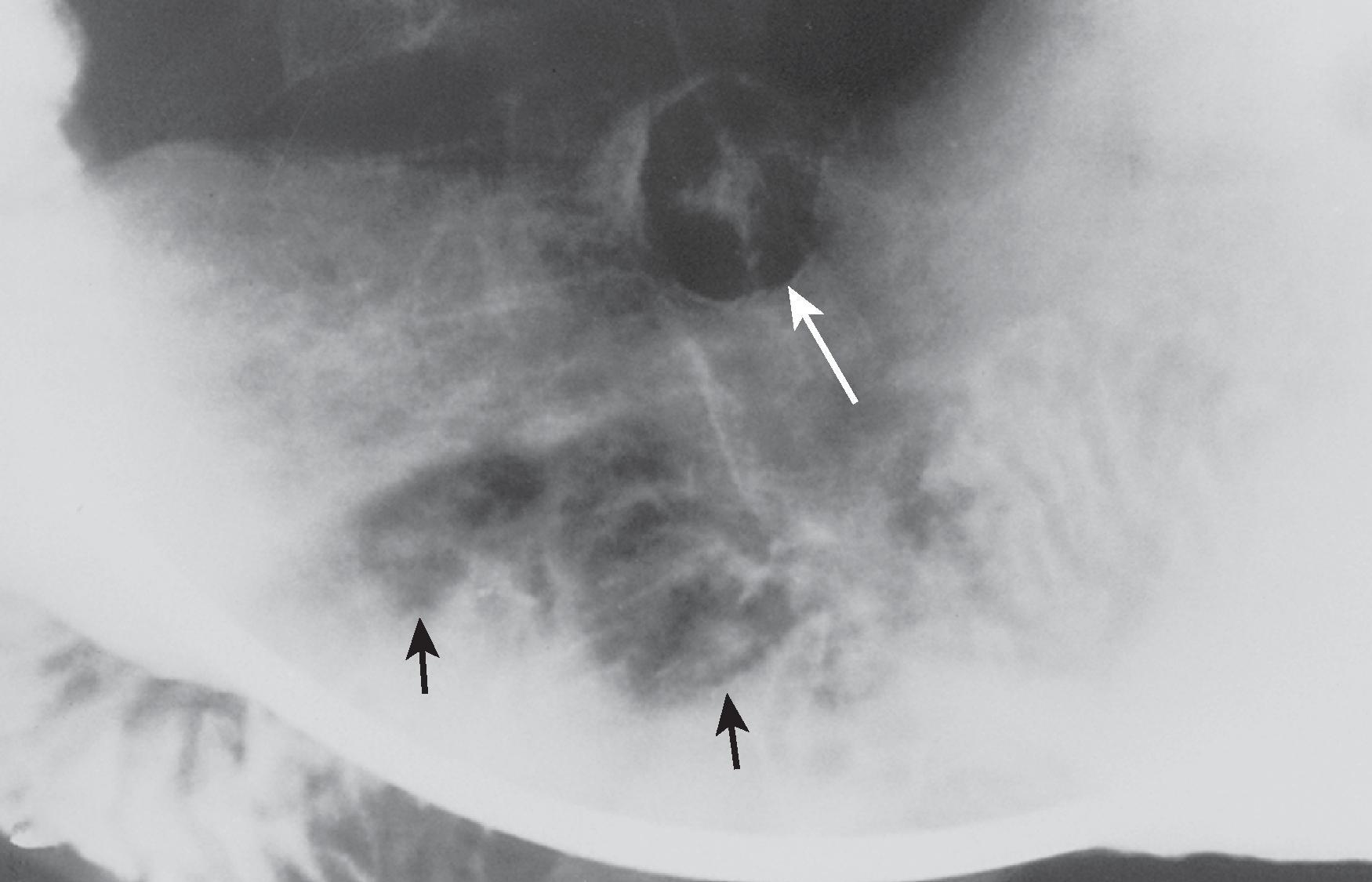
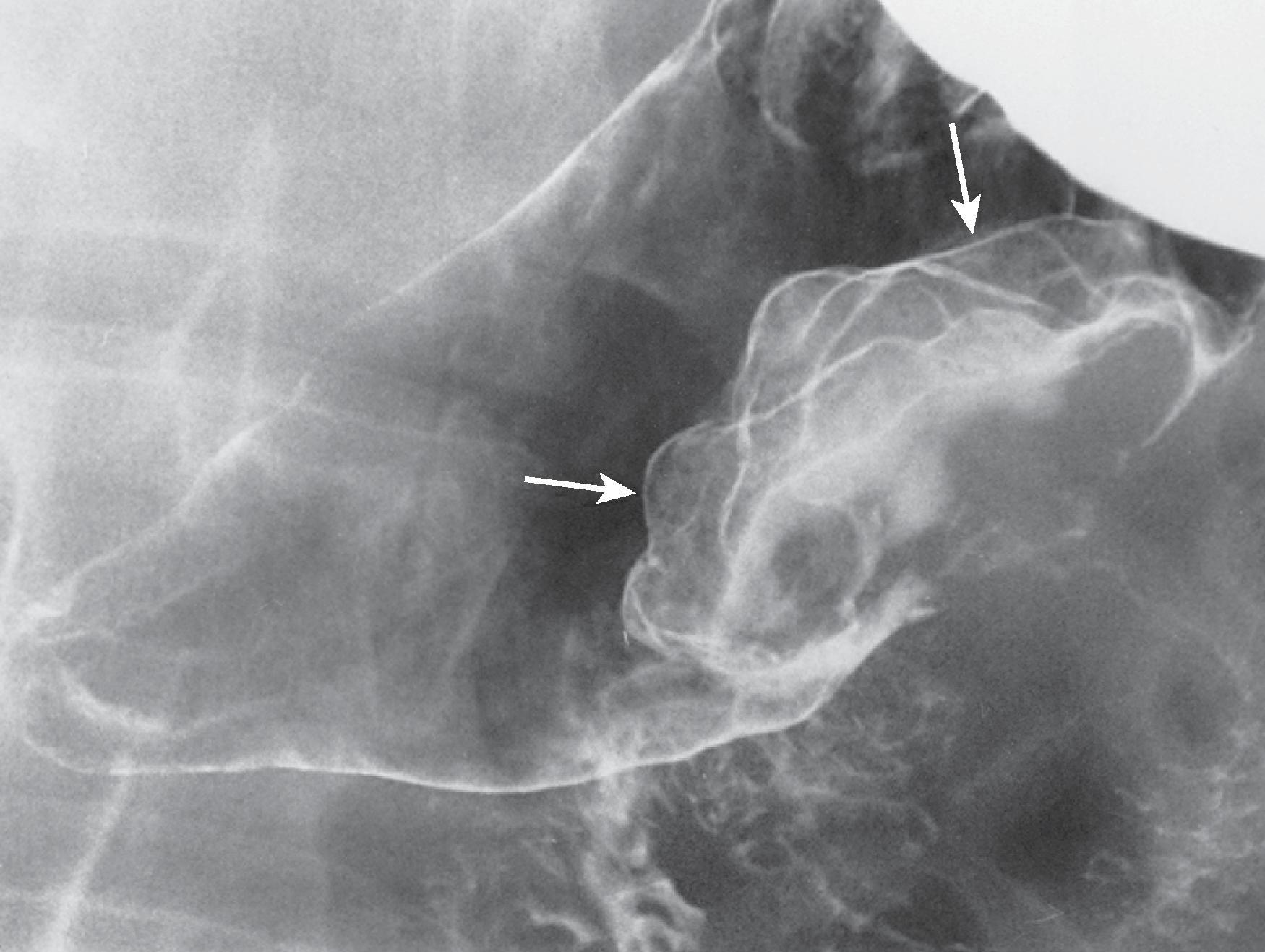
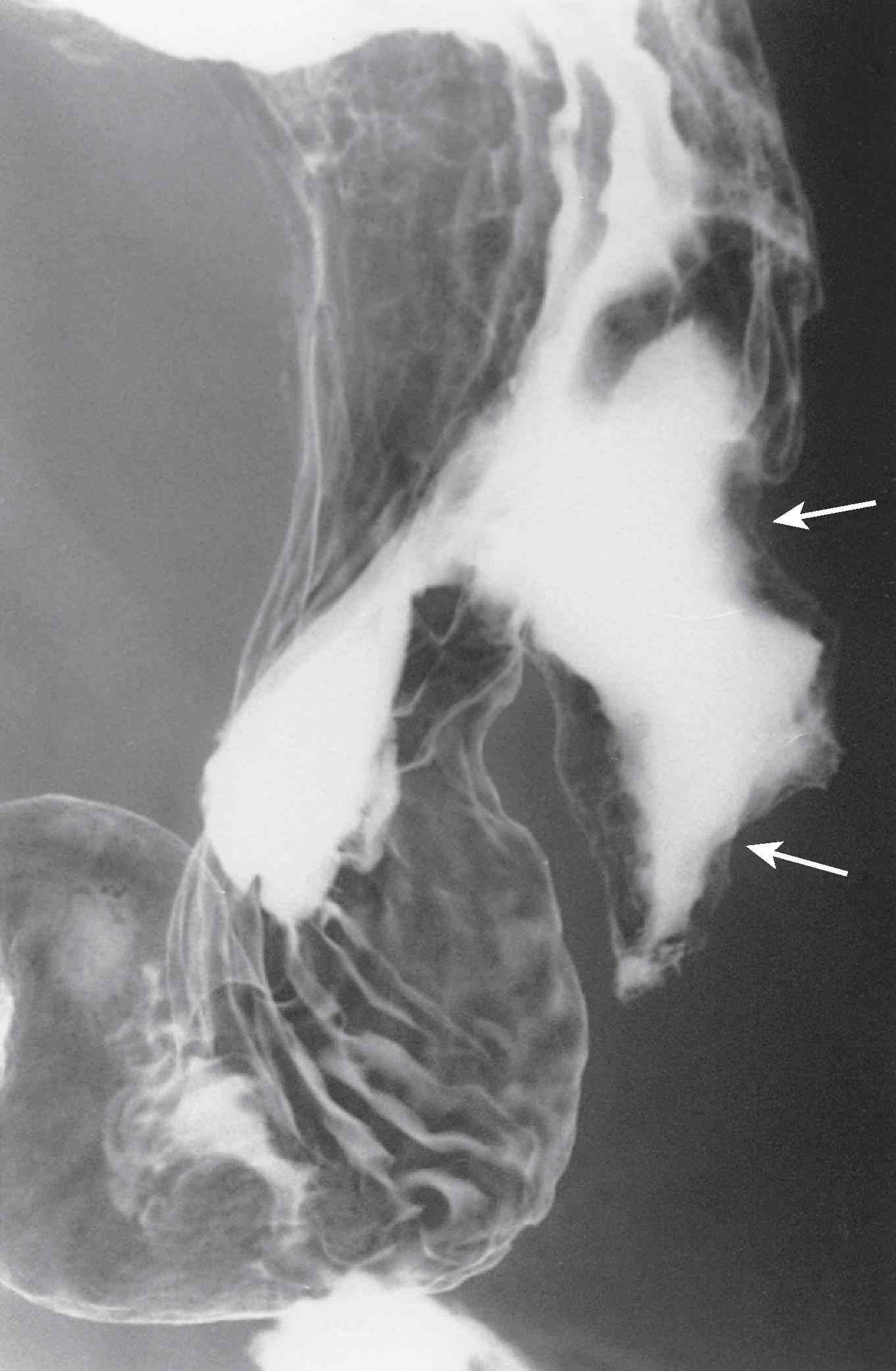
Hematogenous metastases to the stomach from breast cancer may produce a linitis plastica appearance indistinguishable from a primary scirrhous carcinoma. , , This finding is caused not by fibrosis but by highly cellular infiltrates of metastatic tumor encasing the gastric wall. Because the tumor resides deep in the wall, it is often difficult to obtain a definitive diagnosis on endoscopic biopsy specimens. Nevertheless, barium studies may reveal variable narrowing, nodularity, spiculation, ulceration, and thickened, irregular folds in the involved portion of the stomach ( Fig. 21.5A ). Similarly, CT may reveal extensive gastric wall thickening that enhances after intravenous (IV) contrast administration ( Fig. 21.5B ). , For reasons that are unclear, other blood-borne metastases to the stomach rarely, if ever, produce a linitis plastica appearance.
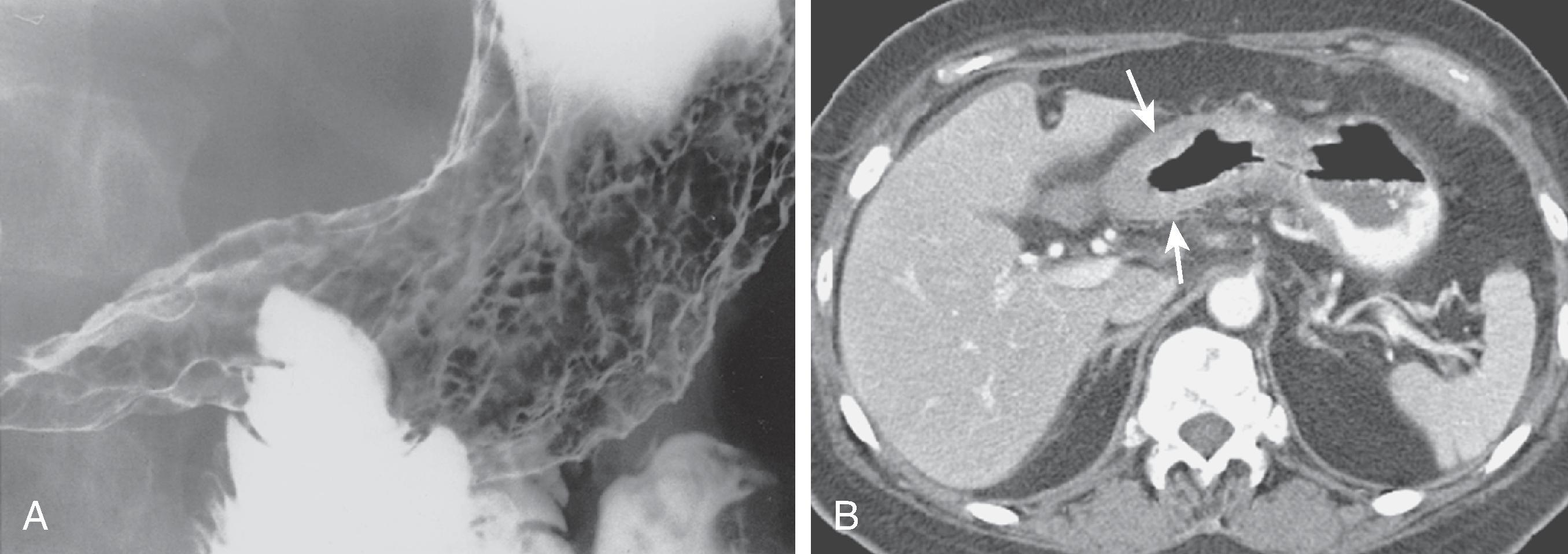
Gastric metastases are common findings at autopsy in patients who die of squamous cell carcinoma of the esophagus. These metastases are caused by tumor emboli that seed the gastric cardia or fundus via submucosal esophageal lymphatics extending subdiaphragmatically to paracardiac, lesser curvature, and celiac nodes. Squamous cell metastases to the gastric fundus are characterized on barium studies by discrete submucosal masses, often containing central ulceration ( Fig. 21.6 ). , As a result, these lesions can be mistaken for benign or malignant GISTs or lymphoma. Squamous cell metastases to paracardiac or other lymph nodes in the upper abdomen are sometimes recognized on CT as multiple low-attenuation masses ( Fig. 21.7 ).
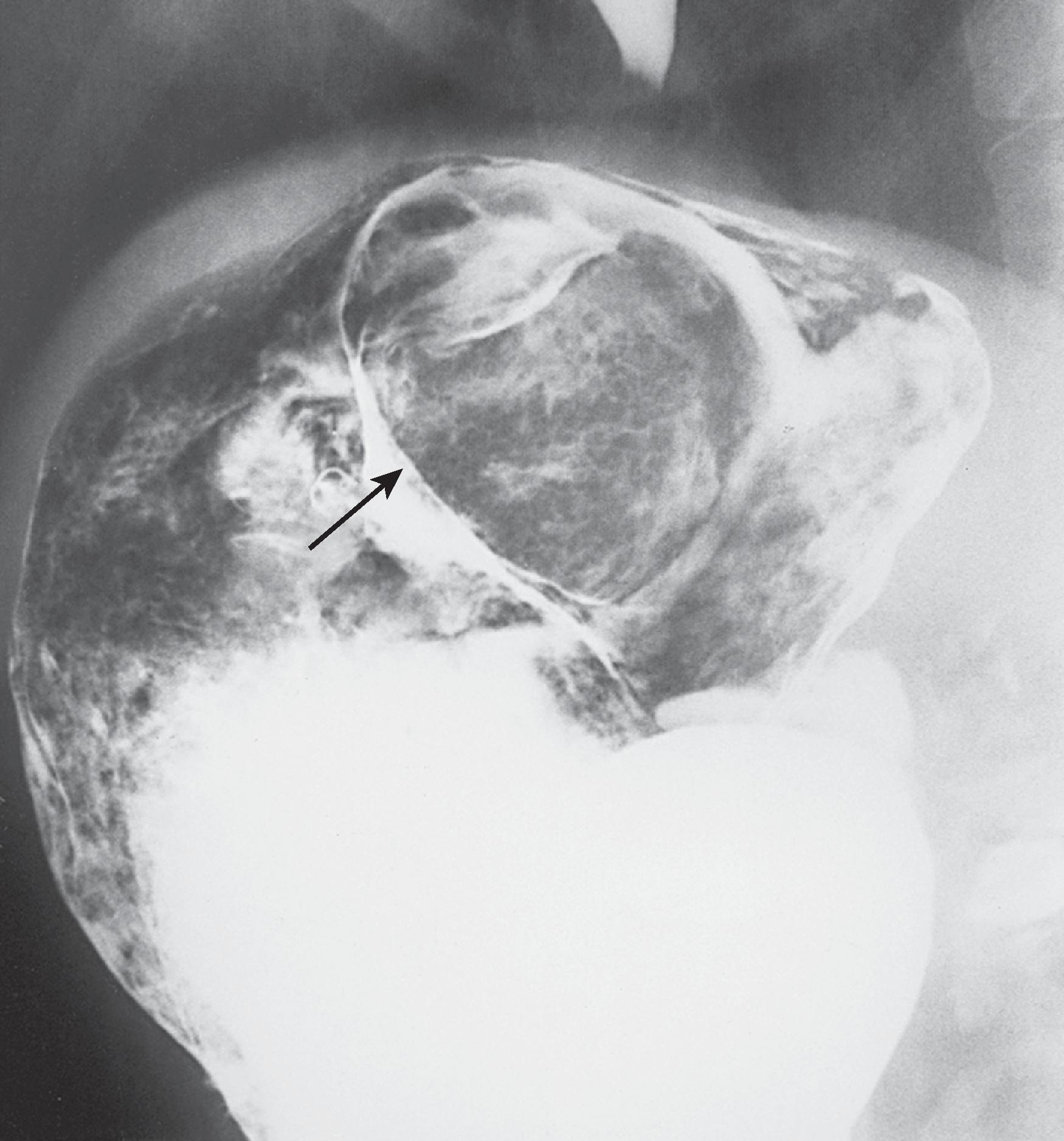
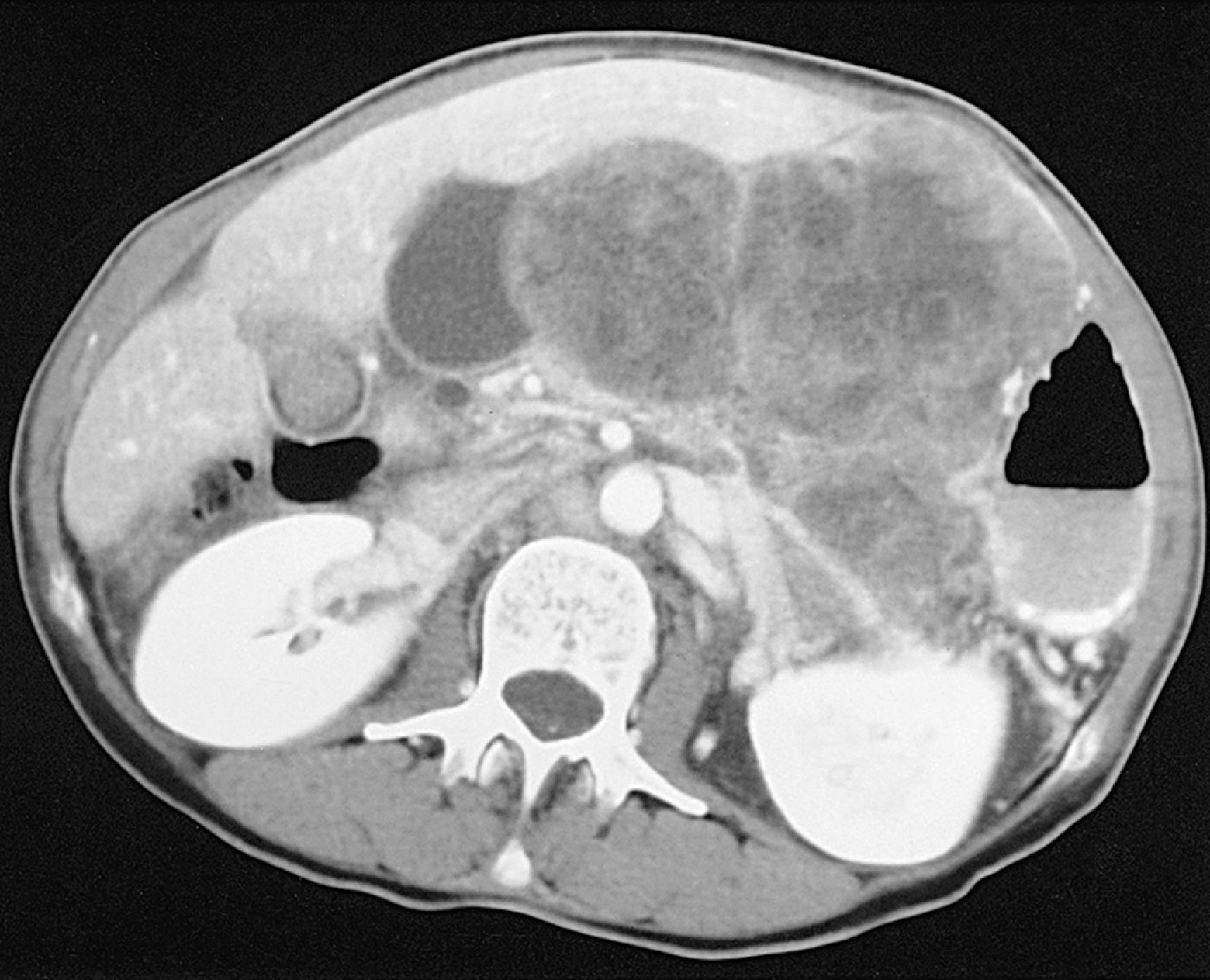
The duodenum may be involved by peripancreatic lymphadenopathy from pancreatic cancer or other malignant tumors. While mass effect on the medial border of the descending duodenum and widening of the duodenal sweep should suggest a pancreatic head mass on barium studies, a true pancreatic mass can usually be differentiated from peripancreatic lymphadenopathy on CT.
Malignant tumors that metastasize to retroperitoneal lymph nodes near the superior mesenteric root are characterized on barium studies by extrinsic mass effect, ulceration, or, in advanced cases, obstruction of the distal duodenum ( Fig. 21.8A ). CT may show retroperitoneal adenopathy encasing the duodenum in these patients ( Fig. 21.8B ). Rarely, retroperitoneal tumors involving the duodenum may cause delayed gastric emptying and massive gastric dilation disproportionate to the degree of duodenal dilation ( Fig. 21.9 ), most likely because of gastric atonia resulting from vagal destruction by retroperitoneal tumor.
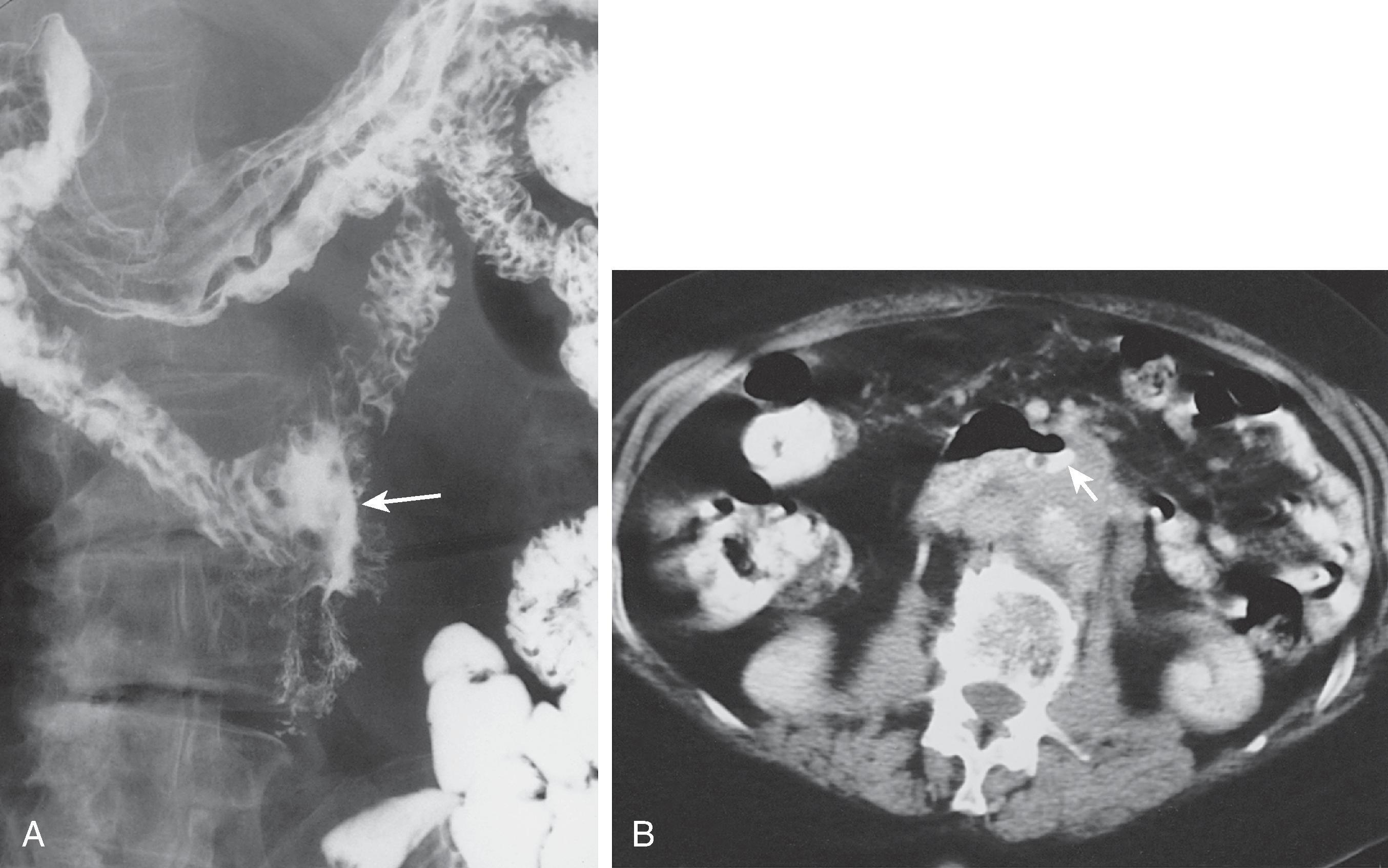
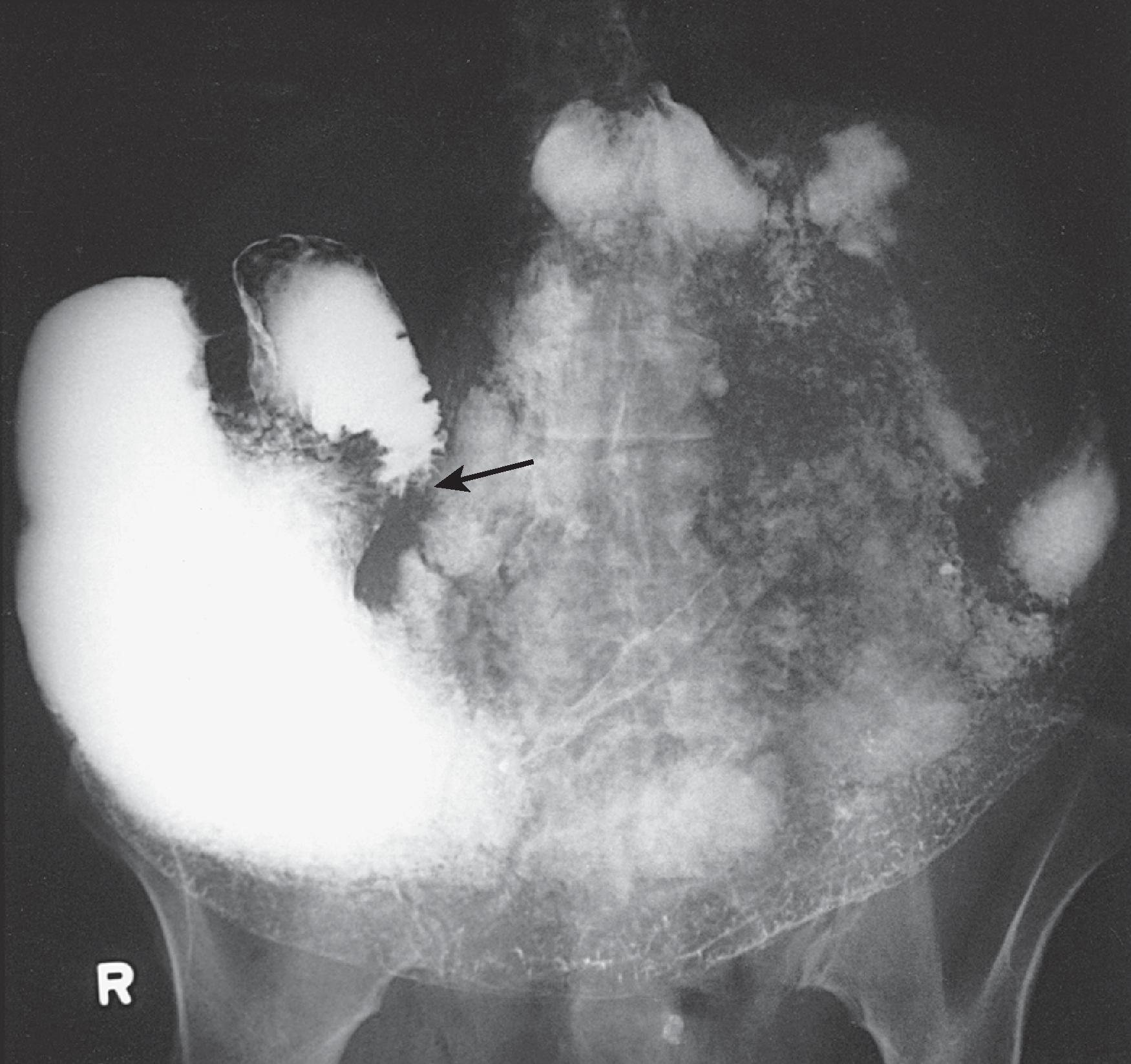
Unlike squamous cell carcinomas, adenocarcinomas of the distal esophagus often invade the gastric cardia and fundus. In advanced disease, gastric involvement by tumor is usually characterized on barium studies by a polypoid or ulcerated fundal mass. In other cases, however, double-contrast views of the fundus reveal distortion of the normal cardiac landmarks and irregular areas of nodularity and ulceration without a discrete mass (see Chapter 12 ).
The findings on barium studies in patients with gastroduodenal involvement by pancreatic cancer depend on where the tumor is located in the pancreas. Pancreatic head cancers cause widening of the duodenal sweep and extrinsic compression of the medial border of the descending duodenum or greater curvature of the gastric antrum, whereas pancreatic body or tail cancers cause extrinsic compression of the posterior wall of the gastric fundus and body or superior border of the distal duodenum. Invasion of the stomach or duodenum by tumor is characterized on barium studies by luminal narrowing, spiculation, nodularity, ulceration, or, rarely, fistula formation ( Fig. 21.10 ).
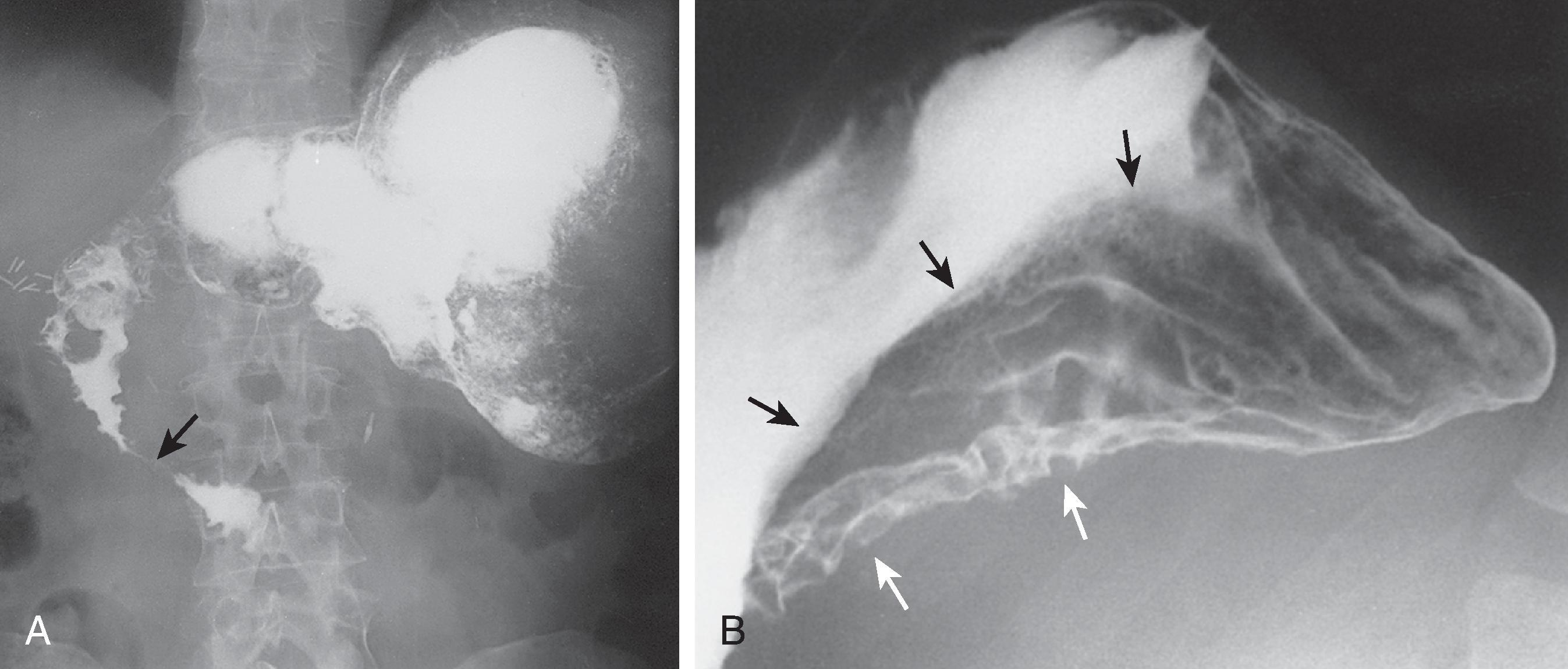
CT has limited value in predicting early duodenal invasion by pancreatic carcinoma, but distention of the duodenum with gas or water can facilitate detection of subtle signs of invasion. CT is of greater value in differentiating pancreatic carcinoma from pancreatic pseudocysts, retrogastric varices, or other retroperitoneal abnormalities compressing the stomach.
Duodenal invasion by a right-sided renal cell carcinoma is usually characterized on barium studies by mass effect, nodularity, tethering, or ulceration of the right posterolateral border of the descending duodenum. Because renal cell carcinoma invading the duodenum does not always elicit a desmoplastic response in the wall of the bowel, however, duodenal involvement by tumor is occasionally manifested by a polypoid mass, mimicking a primary duodenal carcinoma.
Colonic carcinoma may involve the stomach or duodenum by direct extension via mesenteric reflections such as the gastrocolic ligament and transverse mesocolon. The gastrocolic ligament is the proximal portion of the greater omentum that extends superiorly from the anterosuperior border of the transverse colon to the greater curvature of the stomach ( Fig. 21.11 ). Because of this anatomic relationship, carcinoma of the transverse colon may invade the stomach via the gastrocolic ligament, producing mass effect, nodularity, and spiculation on the greater curvature of the gastric antrum or body. In other patients, carcinoma of the ascending colon or hepatic flexure may invade the duodenum via the lateral reflection of the transverse mesocolon, producing mass effect, nodularity, and spiculation on the lateral border of the descending duodenum ( Fig. 21.12A ). , CT is often helpful for showing the mode of spread to the stomach or duodenum ( Fig. 21.12B ).
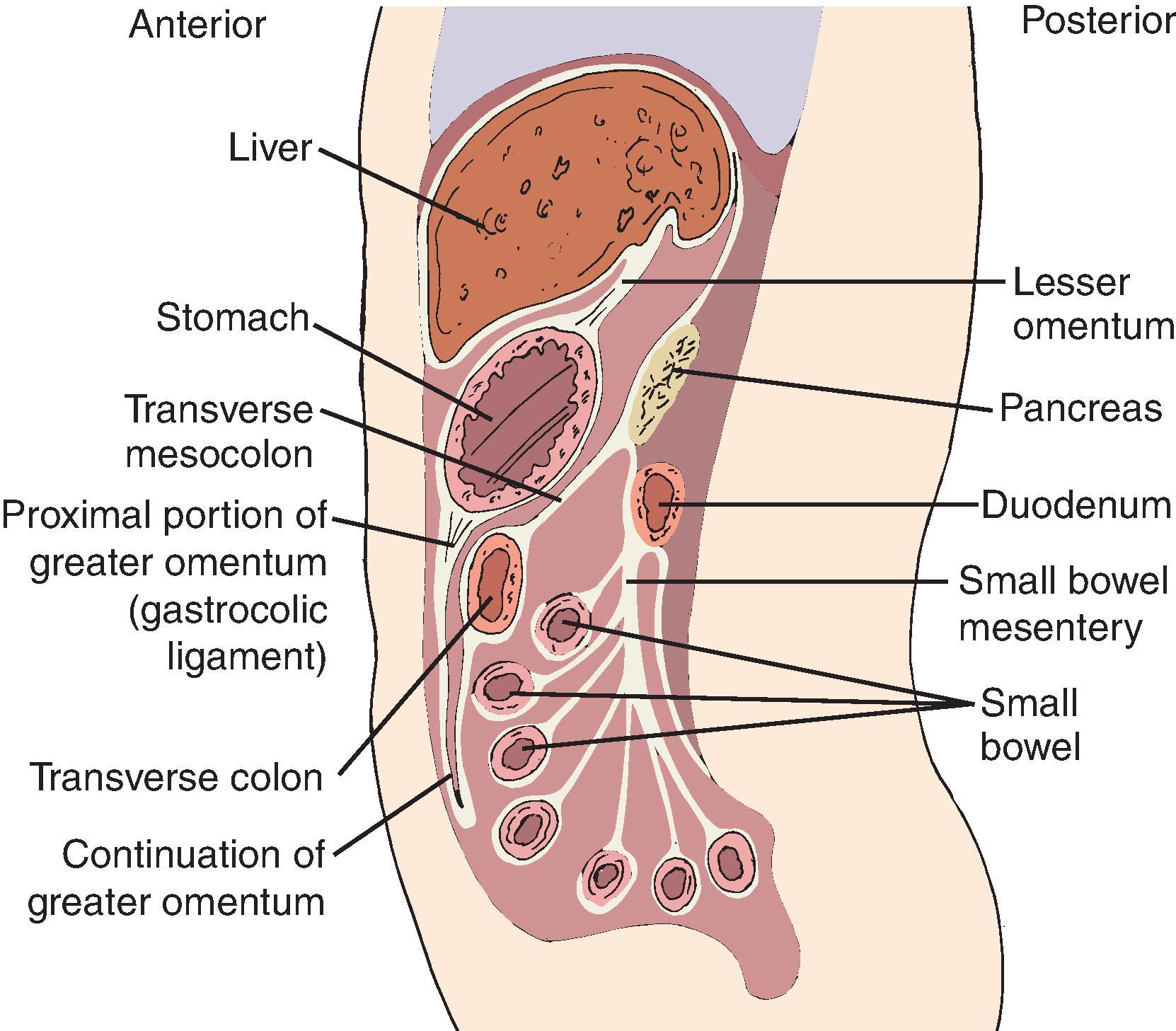
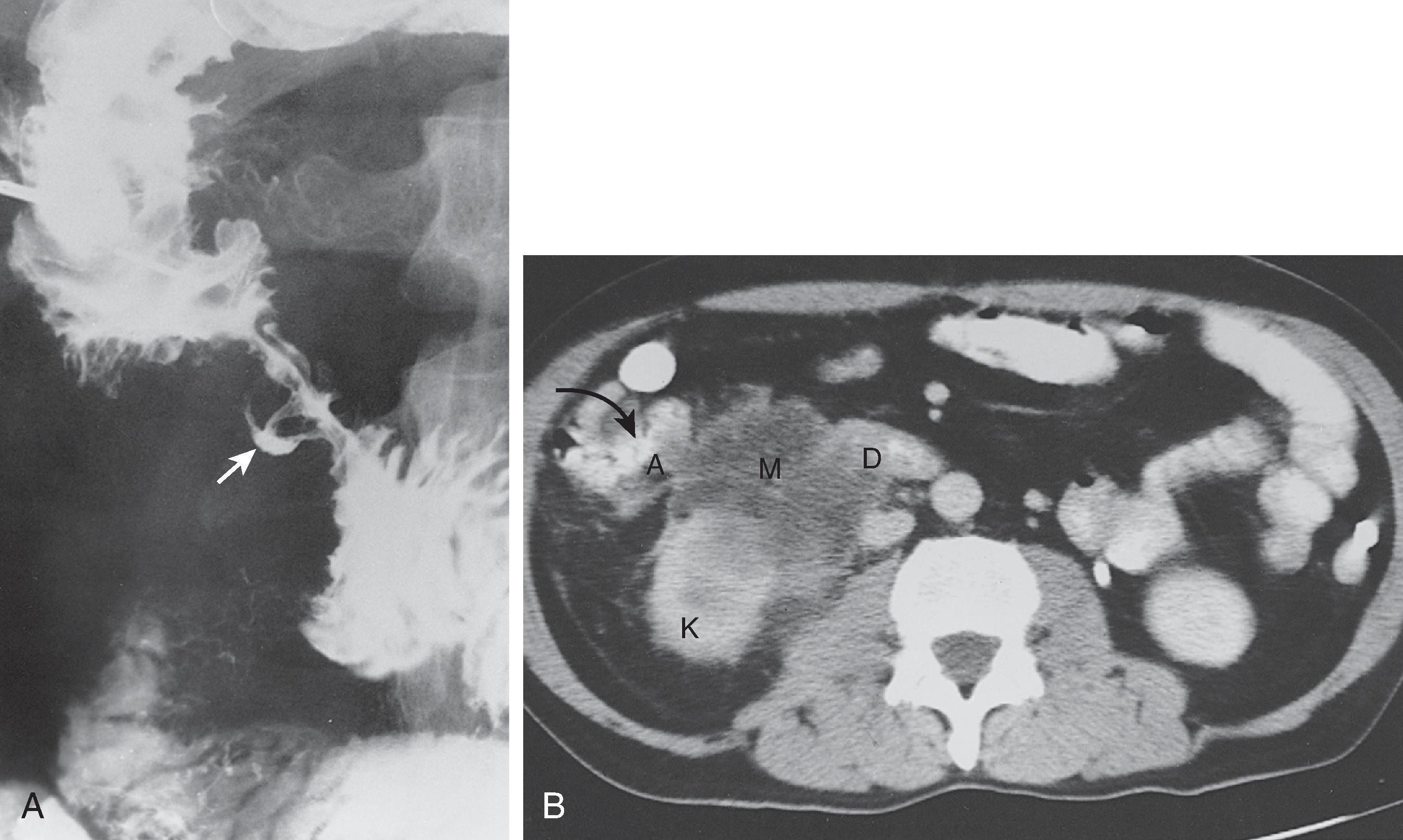
Carcinoma of the transverse colon invading the stomach may occasionally lead to the development of a gastrocolic fistula (see Chapter 22 ). In today’s pill-oriented society, however, most gastrocolic fistulas are caused by penetrating aspirin-induced greater curvature ulcers (see Chapter 17 ).
Advanced gallbladder carcinomas directly invade the duodenum in about 20% of patients. CT is useful for showing gastric or duodenal invasion by tumor ( Fig. 21.13 ).
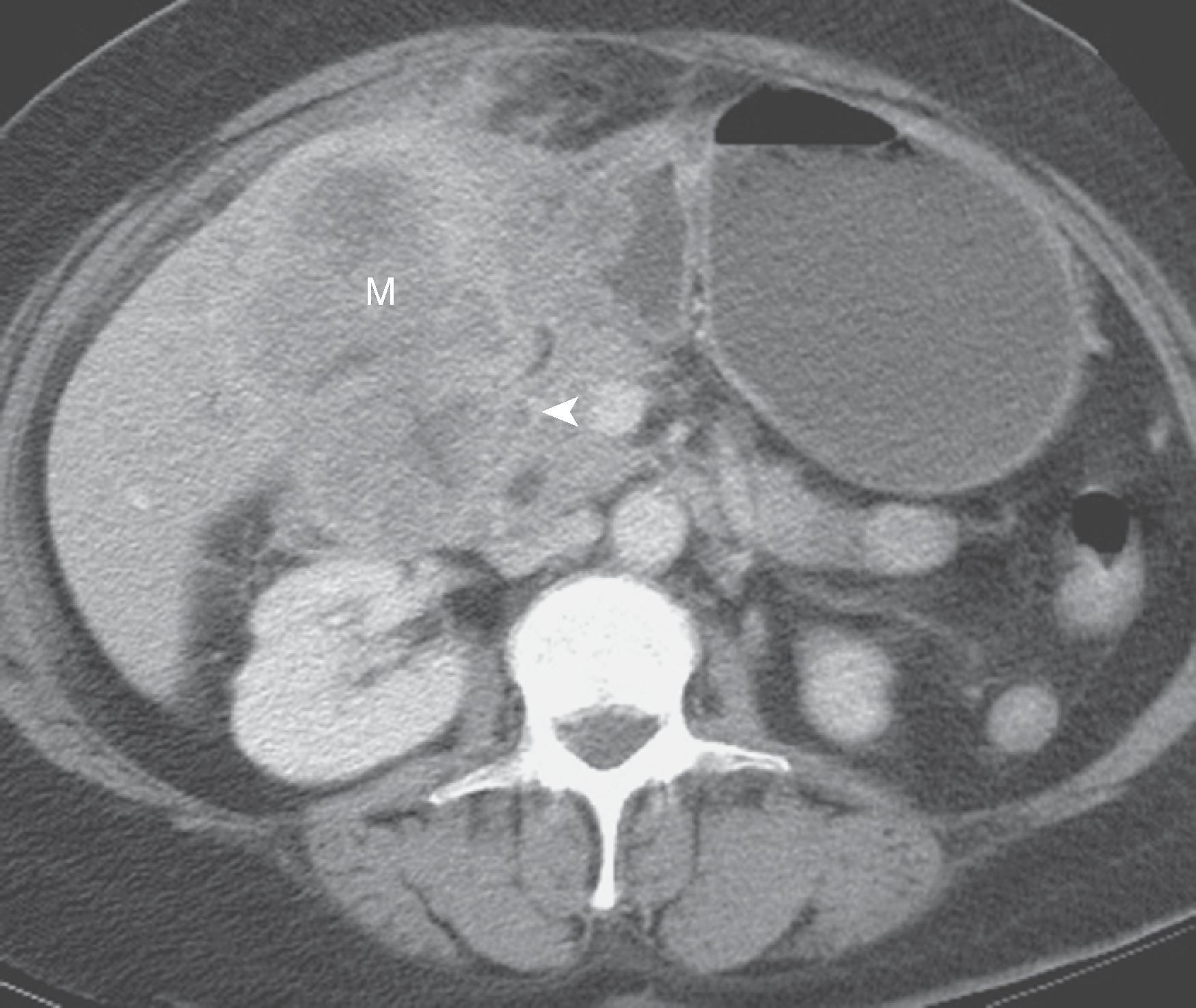
Bulky omental metastases, or so-called omental cakes , usually result from intraperitoneal spread of ovarian carcinoma or, less frequently, cervical, uterine, bladder, gastric, colonic, pancreatic, or breast carcinoma. Omental tumor may subsequently spread superiorly to the greater curvature of the stomach via the proximal portion of the greater omentum (i.e., the gastrocolic ligament) (see Fig. 21.11 ). Gastric involvement by omental metastases is characterized on barium studies by mass effect, nodularity, flattening, and spiculation on the greater curvature of the gastric antrum or body ( Fig. 21.14A ). These findings reflect serosal involvement by tumor and a desmoplastic response that occurs along the insertion of the gastrocolic ligament on the greater curvature.
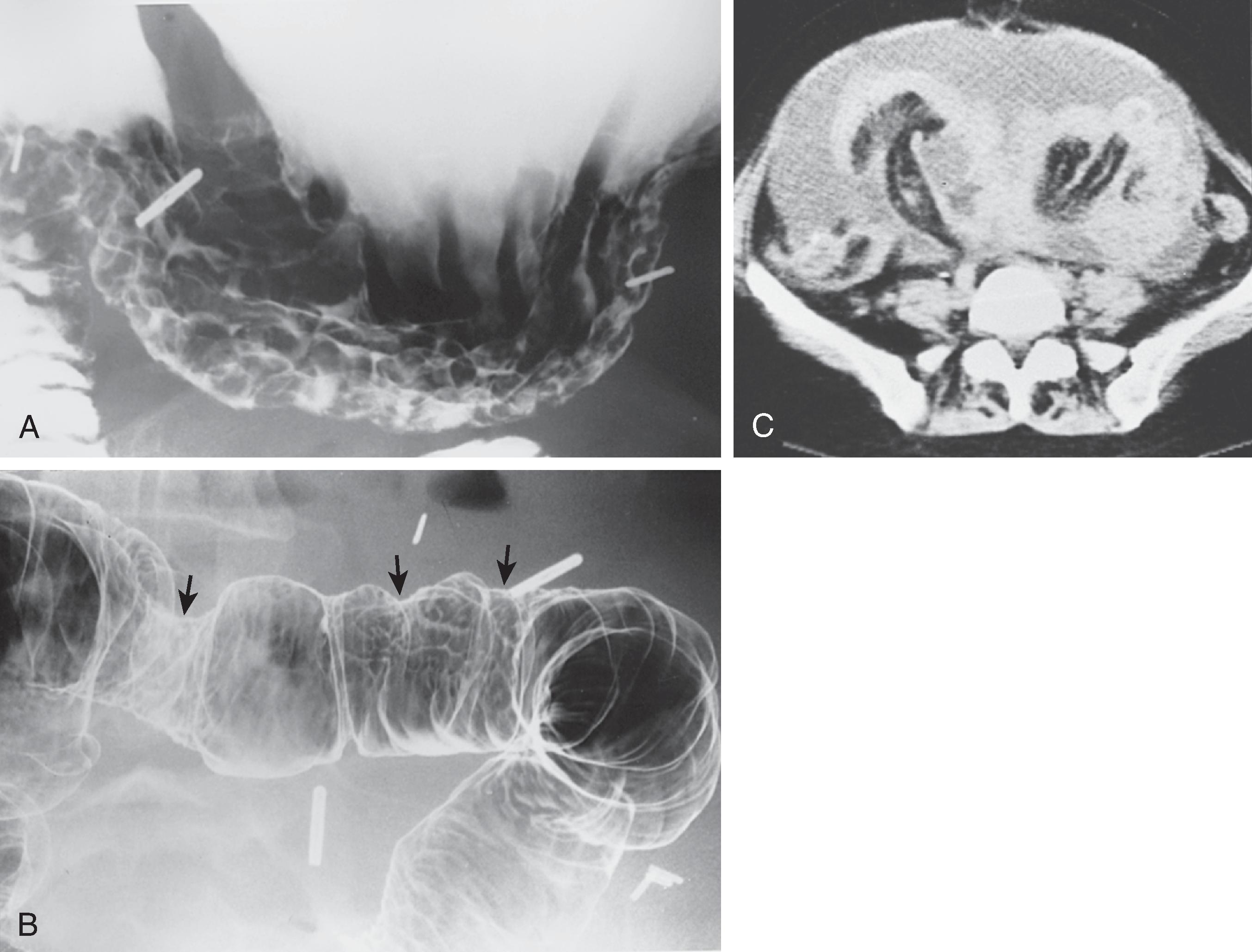
Carcinoma of the transverse colon invading the stomach via the gastrocolic ligament may produce identical findings (see earlier, “Colonic Carcinoma”). In such cases, however, a barium enema examination or CT should demonstrate the colon cancer responsible for these findings. In contrast, patients with omental metastases involving the stomach almost always have associated colonic involvement by omental tumor, manifested by mass effect, nodularity, and spiculation on the superior border of the transverse colon ( Fig. 21.14B ) or, in advanced cases, circumferential narrowing and tethering of the bowel.
When gastric involvement by omental metastases is suspected on barium studies, omental disease may be directly visualized on CT by a spectrum of findings, ranging from a lacy reticular appearance to bulky omental masses ( Fig. 21.14C ). ,
Metastases that have a submucosal appearance can be mistaken on barium studies for other intramural lesions such as GISTs, lipomas, or ectopic pancreatic rests, but these benign mesenchymal tumors tend to occur as solitary lesions, whereas metastases are usually multiple. Centrally ulcerated bull’s-eye lesions are caused not only by hematogenous metastases to the stomach but also by lymphoma and carcinoid tumors. Similarly, giant, cavitated lesions in the stomach and duodenum are caused not only by hematogenous metastases but also by lymphoma and malignant GISTs. The latter tumors usually occur as solitary lesions, however, so the presence of multiple cavitated masses in the stomach, duodenum, or small bowel should favor metastatic disease or lymphoma.
The linitis plastica appearance caused by metastatic breast cancer involving the stomach may be indistinguishable from a primary scirrhous carcinoma or even a circumferentially infiltrating lymphoma. The possibility of metastatic disease should be considered, however, when a linitis plastica appearance is detected in patients with a history of breast cancer.
Compression or displacement of the greater curvature or posterior wall of the stomach or the medial border of the descending duodenum may be caused not only by pancreatic carcinoma but also by pancreatitis, pancreatic pseudocysts, peripancreatic lymphadenopathy, abdominal aortic aneurysms, or other retroperitoneal processes. CT is extremely helpful for differentiating these conditions.
The stomach is the most common site of GI involvement by lymphoma; gastric lymphoma accounts for 50% of GI lymphomas, 25% of extranodal lymphomas, and 3% to 5% of malignant tumors in the stomach. More than 50% of these patients have primary gastric lymphoma with disease confined to the stomach and regional lymph nodes, and the remainder have generalized lymphoma with associated gastric involvement. Duodenal lymphoma is much rarer, and these lymphomas most commonly result from transpyloric spread of tumor from the stomach.
Become a Clinical Tree membership for Full access and enjoy Unlimited articles
If you are a member. Log in here